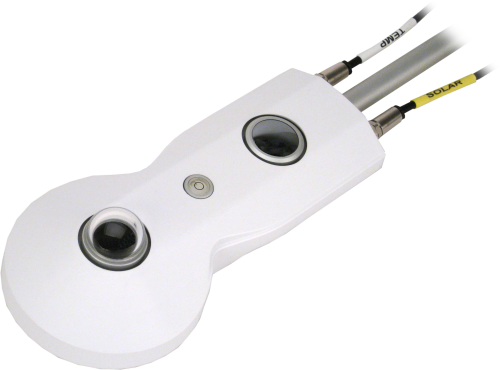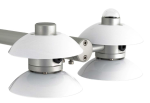
Four-way, research-quality radiometer; thermistor and Pt-100 built in






Overview
The CNR4, manufactured by Kipp & Zonen and cabled for use with Campbell Scientific data loggers, is a research-grade net radiometer that measures the energy balance between incoming and outgoing radiation. Our data loggers measure the CNR4's output. This net radiometer offers a professional solution for scientific-grade energy balance studies.
Read MoreBenefits and Features
- Research-grade performance
- Meniscus dome on upper long-wave detector allows water droplets to easily roll off of it and increases field of view to nearly 180°
- Internal temperature sensors provide temperature compensation of measurements
- Drying cartridge helps keep the electronics dry
- Compatible with the CNF4 ventilation unit with heater that reduces formation of dew and melts frost
- Separate outputs of short-wave and long-wave infrared radiation for better accuracy and more thorough quality assurance
- Solar shield reduces thermal effects on the sensors
The "-L" on a product model indicates that the cable length is specified at the time of order.
Images



Detailed Description
The CNR4 consists of a pyranometer and pyrgeometer pair that faces upward and a complementary pair that faces downward. The pyranometers and pyrgeometers measure shortwave and long-wave infrared radiation, respectively.
The upper long-wave detector of the CNR4 has a meniscus dome that allows water droplets to easily roll off of it. The dome shape also increases the field of view to nearly 180° instead of 150° for a flat window.
The CNR4 contains both an internal thermistor and an internal Pt-100 RTD. Typically, the thermistor makes the instrument housing temperature measurements used to compensate the infrared readings. Alternatively, the RTD can provide these measurements if a CR3000 or CR5000 datalogger is used.
The CNR4 has a solar shield that reduces the thermal effects on both the short-wave and long-wave measurements. A drying cartridge helps keep the radiometer’s electronics dry. The CNF4, an optional ventilation unit with heater, can be fitted onto the CNR4 to minimize the formation of dew as well as melt frost.
Specifications
| Sensor | Two thermopile pyranometers, two pyrgeometers, Pt100 RTD, and thermistor |
| Measurement Description | Measures incoming and outgoing short-wave and long-wave radiation |
| Response Time | < 18 s |
| Temperature Dependence of Sensitivity | < 4% (-10° to +40°C) |
| Sensitivity | 5 to 20 μV W-1 m2 |
| Non-Linearity | < 1% |
| Tilt Error | < 1% |
| Directional Error |
< 20 W m-2 (pyranometer) Angles up to 80° with 1000 W/m2 beam radiation |
| Operating Temperature Range | -40° to +80°C |
| Compliance | Conforms to the CE guideline 89/336/EEC 73/23/EEC. |
| Height | 6.6 cm (2.6 in.) dome-to-dome |
| Width | 11.1 cm (4.4 in.) |
| Length |
|
| Weight | 850 g (30.0 oz) without cable |
Pyranometer |
|
| Spectral Range | 305 to 2800 nm |
| Uncertainty in Daily Total | < 5% (The uncertainty values are for a 95% confidence level.) |
| Output Range | 0 to 15 mV (The output range is typical for atmospheric applications.) |
Pyrgeometer |
|
| Spectral Range | 4500 to 42,000 nm |
| Uncertainty in Daily Total | < 10% (The uncertainty values are for a 95% confidence level.) |
| Output Range | ±5 mV (The output range is typical for atmospheric applications.) |
Compatibility
Note: The following shows notable compatibility information. It is not a comprehensive list of all compatible or incompatible products.
Data Loggers
| Product | Compatible | Note |
|---|---|---|
| CR1000 (retired) | When using a CR1000, the internal temperature of the CNR4 should be measured with the internal thermistor. | |
| CR3000 (retired) | ||
| CR6 | ||
| CR800 (retired) | ||
| CR850 (retired) |
Additional Compatibility Information
Mounting
To avoid shading or reflections and to promote spatial averaging, the CNR4 should be mounted at least 1.5 m above the ground or crop canopy and away from all obstructions or reflective surfaces that might adversely affect the measurement.
The CNR4 can be attached to a vertical pipe or horizontal crossarm. To do this, first connect the radiometer to its mounting rod. The mounting rod then attaches to the pipe or crossarm via the 26120 Net Radiation Sensor Mounting Kit. The kit includes adjustment screws for leveling the CNR4. The 26120 can withstand winds up to 120 mph.
Data Logger Considerations
Four differential channels or four single-ended channels are used to measure the radiation components. A voltage excitation channel and an additional single-ended channel are required to measure the thermistor. If the RTD is used to provide the temperature compensation measurement, a current excitation channel (only available on the CR3000 and CR5000) and a differential channel are required.
Documents
Brochures
Manuals
Frequently Asked Questions
Number of FAQs related to CNR4-L: 11
Expand AllCollapse All
Case Studies
This case study discusses the integration of CPEC310 and AP200 systems to explore the theories......read more
Currently, the Andean tropical glaciers are in an accelerated process of retreat. These glaciers are......read more
Scientists and land-use managers have long recognized the importance of forest lands for their role......read more
Articles and Press Releases
Newsletter Articles
Privacy Policy Update
We've updated our privacy policy. Learn More
Cookie Consent
Update your cookie preferences. Update Cookie Preferences





